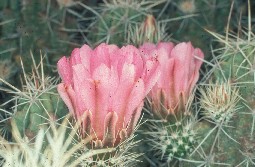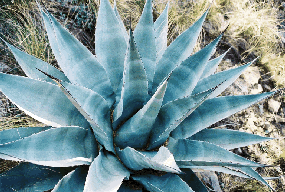 |
 | |
  | |
|
|
|
|
Big Bend National Park
Cacti / Desert Succulents
|
|
|
|
|
|
 |
 |
 |
| NPS/Big Bend National park | | Pitaya cactus blooming. Note the areoles where the spines come out of the fruit. |
 |
Cactus
There are more species of cacti (or cactuses, either is accepted) in Big Bend National Park than any other park. As many as 65 taxa of cactus can be found in the park. The diversity of cactus is a result of our location and the diversity of landforms in the park. Big Bend is located in the northern Chihuahuan Desert, a desert that is in itself known for cactus diversity. But the park also has botanical influences from nearby biomes such as the Edwards plateau, Tamaulipan thornscrub, Sierra Madre, and southern Rocky Mountains. The variety of habitats created by the diversity of elevation, geology, and soils allows many of these species to occupy small areas of suitable habitat in the park.
Many park visitors plan their visits to Big Bend National Park around viewing these beautiful plants when they are in bloom. In most years April is the best month to see many species of cactus in bloom, though in especially wet years we could have something blooming every month of the year.
Did you know that cactus are only found in the Americas? So what makes a cactus a cactus?
The answer to these questions can be found right here in Big Bend. First, Chihuahuan Desert cacti are succulents, meaning they store water beneath a thick fleshy outer "skin". Often succulents have a waxy appearance as well. One of the most distinctive characteristics of the cactus is its areole. The areole, often raised on a fleshy knob called a tubercle, is a feature that is only found in the cactus family. This is an opening on the epidermis of the cactus where spines come out and gas exchange occurs with the environment. The flowers of most of our cactus species vary in size and color, but are actually quite similar in structure. They all have an outer ring of showy tepals (combined sepals and petals), a mass of numerous pollen-producing stamens, and a single pistil in the center. Once pollinated the pistil grows to become the cactus fruit. The fleshy fruits are called “tunas” on prickly pears, and edible “pitayas” on some members of the hedgehog cactus group.
|
 |
| Robert Krause | | Century plants bloom once in a life time, then spread their seeds, and then the final chapter...death |
 |
Desert Succulents
Not all succulents are cacti. Big Bend has numerous succulent plants, many of which are unique to the Chihuahuan Desert. Agaves and yuccas are succulents, but are more closely related to lilies than cacti. One of the most popular plants in Big Bend is the century plant, also called Havard agave, which sends up tall branched flower stalks in early summer. Often it is considered a plant that blooms once in a hundred years, but this is a misconception. Research has shown that century plants can bloom after 20 to 30 years of growth.
The most common agave here is the lechuguilla plant. Lechuguilla is the indicator species of the Chihuahuan Desert. In other words if you were dropped out of the sky and you landed on one of these spiny devils, you would know that you are in the Chihuahuan Desert.
Another popular succulent plant in Big Bend is the candellila plant, a member of the spurge family. Even to this day people are using this plant to produce candellila wax, a product that is found in more items than you are probably aware of. Candellila was an important plant to many of the settlers to Big Bend before it was established as a park, and one town (Glenn Springs) was centered around its refinement.
|
|  |

|
 |
|
|
|
|
|
 |
|
Did You Know?
Traveling through the Big Bend during the 1860 camel experiment, Lt. William Echols reported that camels did well in the desert, but that they suffered from sore feet.
“I would recommend to any one using the camels over rough country, in case of tender feet, to shoe them with a piece of raw hide…”
more...
|
|
|
|
Last Updated: February 29, 2008 at 15:40 EST |






